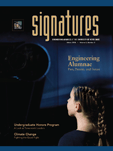
 |
The Green PartyAccording
to the article “Making Dirty Coal Plants Cleaner” in
the July 13 issue of Science, emissions from coal-fired
plants are responsible for almost a third of the greenhouse gases
caused by humanity. In the United States alone, the gases these plants
produce surpass the amount generated by cars and all other industries
combined. Is it any wonder that finding a way to curb these carbon
emissions is a popular idea? Edward J. Maginn, professor
of chemical and biomolecular engineering, who is quoted in the article,
says there are basically three approaches to capturing the carbon
dioxide (CO2)
in flue gas: pre-combustion capture, post-combustion capture, and
oxy-firing. Maginn, along with Joan F. Brennecke, the
Keating-Crawford Professor of Chemical and Biomolecular Engineering
and Director of the Notre Dame Energy Center, William F.
Schneider, associate professor of chemical and biomolecular
engineering, and a team of Notre Dame researchers are concentrating
on post-combustion activities, which apply to the majority of the
world’s power plants. What’s unique about their activities
is that they are using ionic liquids (ILs),
a relatively new class of chemicals that are liquid at room temperature,
to create an environmentally friendly absorption process. |
|||
 |
|||
Notre Dame team uses atomic-scale simulations of ionic liquid-carbon dioxide interactions to complement their laboratory experiments. |
|||
